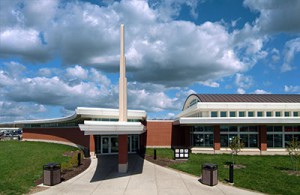 LOCATION:
LOCATION:
Milepost 237.2 – Westbound
Between Exit 239 and 234
County: Mahoning
How it got its name
FUEL SERVICES:
FOOD SERVICES:
 Panera Bread
Panera Bread
 DQ Grill & Chill
DQ Grill & Chill
 Oath Pizza
Oath Pizza
TRUCKERS LOUNGE
- Designated truckers lounge with easy access from the 101-space commercial truck parking lot
- Separate restrooms & complimentary shower facilities
- Coin-operated washer & dryers with vended towels, sundries, and laundry supplies
- Touch & Win Ohio Lottery EZ Play video gaming terminals
OTHER SERVICES:
- 7-Eleven Convenience Store – Customers looking for on-the-go snacks, beverages, food and travel supplies can find them here
- Snack and beverage vending machines
- Travel Board InfoCenters and Turnpike Television (traffic alerts and weather information)
- ATM
- Ohio Lottery- 7-Eleven Convenience Store is the authorized Ohio Lottery retailer at this location.
- E-ZPass – stop by the 7-Eleven Convenience Store at this location to pick up an E-ZPass transponder for your next trip. (Passenger car customers only)
HOW MAHONING VALLEY SERVICE PLAZA GOT ITS NAME
Along the Mahoning River, north of the Mahoning Valley Service Plaza, lies a 25-mile stretch of steel mills and related industries so important to this nation’s economy that it is often compared with Germany’s prized Ruhr Valley. At night a shimmering orange glow in the skies north of the Turnpike reflects the fires in the busy mill furnaces.
Since coal, iron ore and limestone are the three essentials in the production of steel, the Mahoning Valley’s importance as a steel center results largely from its proximity to the Lake Erie ports that receive iron ore from the west; to the coal fields of Ohio, Pennsylvania and West Virginia; and to limestone deposits that are quarried in large quantities near the eastern end of the Turnpike. This choice location in the corridor between Lake Erie and the Ohio River also places it on or close to the principal east-west railroad lines, airplane routes, public highways and the Ohio Turnpike.
When the Ohio Turnpike, the Indiana Toll Road and the Pennsylvania and New Jersey Turnpikes are completely linked in a New York-to-Chicago chain of super-expressways, the Mahoning Valley will have an advantageous position near the mid-point of the route.
More than half a million people live in the metropolitan area of Youngstown, the metropolis of the Mahoning Valley, and most of them earn their livelihood directly or indirectly from the steel industry.
The production of steel and steel products in the Mahoning Valley and elsewhere in Ohio provides one-sixth of the income of Ohio’s citizens. This industry far exceeds any other industry in Ohio in its output, placing the state second only to Pennsylvania in steel-production. In such closely allied lines as forgings, bolts and nuts, stamped and pressed metal products, Ohio leads the nation. It stands first also in the manufacture of other products such as rubber tires, clay products and office machinery.
The Mahoning Valley steel-producing area includes Youngstown, Warren, Alliance, Niles and a thriving network of smaller cities. Youngstown was founded in 1797 by John Young, of Whitestown, New York, who had purchased land at the junction of Mill Creek and the Mahoning River from the Connecticut Land Company. He was soon joined by Colonel James Hillman, a trader whose friendship with the Indians insured the new settlement’s security. Warren was established in 1798 by Ephraim Quinby and Richard Storr, stockholders in the Connecticut Land Company. Two years later it became the seat of government for the Connecticut “Western Reserve,” which included most of what is now northeast Ohio. Settlers came into the Western Reserve by way of the Mahoning Valley, and the Connecticut Land Company’s office was established in Youngstown.
Alliance, at the upper end of the Mahoning Valley, was established in 1805 by six Quakers from Virginia. Niles, the birthplace of President William McKinley, was settled in 1806 by James Heaton, pioneer in the iron industry.
Interest in iron production began with the establishment of the first settlements. In 1802, James and Daniel Heaton set up a crude smelter on Yellow Creek at the site of the present city of Struthers, utilizing native bog ores and charcoal from the virgin timber. The real development of the iron industry in the entire region, including Pittsburgh, dates from the construction in 1845 of a furnace at Lowellville in eastern Mahoning County to utilize raw Mahoning County coal, limestone and ore. The expansion of this industry was stimulated by the coming of the first railroad through the valley in 1853, and the increased demand for iron during the Civil War. Brier Hill coal of the Sharon vein and of high metallurgical quality was used by the early iron makers, but most coal now used in the Mahoning Valley comes from Pennsylvania and West Virginia mines. There is some strip-mining in the valley, evidences of which may be seen in the spoil banks at several locations along the Turnpike.
In 1892 Youngstown became the site of the first steel plant in the valley. Soon the banks of the Mahoning River were resounding with the roar and boom of Bessemer converters, open-hearth furnaces, strip and rolling mills, pipe plants and other factories manufacturing kindred products.
Although the demand for steel keeps money jingling in the pockets of Mahoning Valley workers, it has not changed all of the valley into a region of mills and shops. Between the Turnpike and the Mahoning River lies Mill Creek Park, a peaceful scenic area abounding in ravines and cliffs running to a deep gorge by Mill Creek as it winds through southwestern Youngstown on its way to the Mahoning River. The natural beauty of the park has been enhanced by the impounding of several small lakes.
Another tributary of the Mahoning River, Meander Creek, has been dammed to form the Meander Reservoir that with its pine-covered surroundings is one of the outstanding beauty spots along the Ohio Turnpike, which crosses the lake just east of the Niles-Youngstown interchange. The lake and its forested shores constitute a wildlife preserve, and Turnpike travelers may, on occasion, catch a glimpse of the deer that find refuge there.